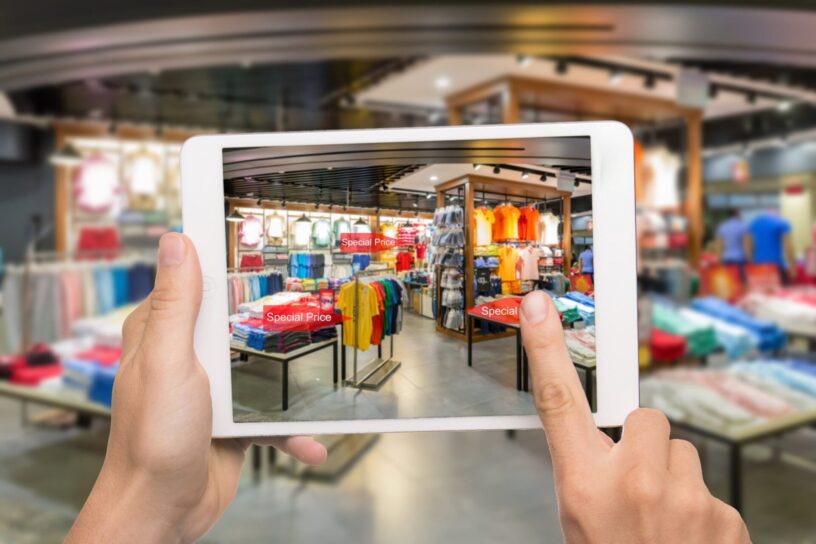Retail Application Market Overview:
The Retail Application Market encompasses a wide range of technologies and solutions designed to enhance the shopping experience, streamline operations, and drive sales in retail environments. Among the most critical components within this market are displays, which serve as essential tools for showcasing products, engaging customers, and conveying brand messaging. This comprehensive overview delves deep into the historical developments, current trends, product portfolio, production processes, restraints, and data triangulation methods relevant to the Retail Application Market, with a specific focus on displays.
Historical Developments:
The use of displays in retail environments dates back to the early 20th century when merchants began utilizing signage and visual merchandising techniques to attract customers and promote products. These early displays consisted primarily of static signs, posters, and window displays, which were manually updated and replaced as needed. However, with the advent of electronic display technologies in the latter half of the century, the retail landscape underwent a significant transformation.
The 1970s saw the emergence of cathode ray tube (CRT) displays, which enabled retailers to showcase dynamic content and graphics in-store. These displays were initially limited in size and resolution but paved the way for more advanced technologies to come. In the 1990s, the introduction of liquid crystal display (LCD) and plasma display panel (PDP) technologies revolutionized the retail display market, offering larger screen sizes, higher resolutions, and improved color reproduction.
The early 2000s witnessed further advancements with the proliferation of flat-panel displays, LED-backlit LCDs, and digital signage solutions. These displays enabled retailers to deploy dynamic and interactive content, including videos, animations, and real-time promotions, to captivate shoppers’ attention and drive purchase decisions. Moreover, the integration of touch-screen technology and interactive kiosks introduced new opportunities for customer engagement and self-service experiences in retail environments.
In recent years, the retail display market has continued to evolve with the rise of omnichannel retailing, mobile commerce, and digital transformation initiatives. Retailers are increasingly investing in integrated display solutions that seamlessly bridge online and offline channels, providing customers with a unified shopping experience across multiple touchpoints. This includes interactive displays, virtual reality (VR) experiences, and augmented reality (AR) applications that blur the lines between physical and digital retail environments.
Trends:
Several key trends are shaping the evolution of the Retail Application Market and influencing the demand for display solutions:
- Omnichannel Retailing: Retailers are embracing omnichannel strategies to create seamless shopping experiences across online and offline channels. Displays play a crucial role in this strategy by providing consistent branding, product information, and promotional messaging across various touchpoints, including brick-and-mortar stores, websites, mobile apps, and social media platforms.
- Personalization: With the growing emphasis on customer personalization and customization, retailers are leveraging displays to deliver targeted content and offers based on individual preferences, purchase history, and demographic data. Interactive displays and digital signage systems enable retailers to tailor their messaging to specific audience segments and enhance engagement and conversion rates.
- Experiential Retail: Retailers are shifting towards experiential retail concepts that focus on creating immersive and memorable shopping experiences. Displays are central to this trend, facilitating interactive product demonstrations, virtual try-on experiences, and AR-powered showrooming initiatives that engage customers and drive foot traffic and sales.
- Sustainability: As environmental concerns become increasingly important to consumers, retailers are adopting sustainable practices and eco-friendly display solutions. This includes energy-efficient LED displays, recyclable materials, and digital signage systems that reduce paper waste and carbon emissions associated with traditional print advertising.
- Data Analytics: Retailers are leveraging data analytics and artificial intelligence (AI) technologies to optimize display performance, measure customer engagement, and track the effectiveness of marketing campaigns. By analyzing data collected from sensors, cameras, and mobile devices, retailers can gain valuable insights into shopper behavior and preferences, enabling them to refine their display strategies and improve ROI.
Product Portfolio:
The product portfolio for display solutions in the Retail Application Market encompasses a wide range of technologies and form factors tailored to diverse retail environments and applications. Key products include:
- Digital Signage Displays: Digital signage displays are versatile solutions used for advertising, branding, and informational purposes in retail stores, shopping malls, airports, and other public spaces. These displays range from small LCD screens and video walls to large-format LED displays, offering high brightness, resolution, and connectivity options for displaying dynamic content.
- Interactive Touch Screens: Interactive touch screens enable customers to engage with products, access additional information, and complete transactions directly from the display interface. These displays are commonly used in retail kiosks, self-service checkout counters, and product demonstration areas to enhance customer convenience and streamline the shopping process.
- Transparent Displays: Transparent displays feature see-through screens that allow viewers to see the physical products behind the display while overlaying digital content such as product information, promotions, and interactive elements. These displays create visually striking merchandising displays and can be integrated into store windows, shelving units, and product showcases to attract attention and drive sales.
- Augmented Reality (AR) Mirrors: AR mirrors combine reflective surfaces with digital overlays to create immersive virtual try-on experiences for apparel, cosmetics, eyewear, and accessories. Customers can use AR mirrors to visualize themselves wearing different products, experiment with styles and colors, and receive personalized recommendations based on their preferences and body measurements.
- Projection Mapping: Projection mapping technologies project dynamic images and animations onto three-dimensional surfaces, transforming ordinary objects and spaces into interactive storytelling experiences. Retailers use projection mapping to create immersive brand installations, themed environments, and promotional displays that captivate audiences and leave a lasting impression.
Production Mode & Process:
The production of display solutions for the Retail Application Market involves a series of stages and processes to design, manufacture, and deploy innovative and reliable products. The production mode and process for display solutions typically include the following steps:
- Design and Concept Development: The design phase begins with conceptualizing display solutions that meet the specific requirements and objectives of retail clients. Designers and engineers collaborate to develop creative concepts, functional prototypes, and 3D renderings that visualize the form, functionality, and user experience of the display solutions.
- Technology Selection and Integration: Once the design is finalized, manufacturers select appropriate display technologies and components based on factors such as display size, resolution, brightness, and connectivity requirements. This may involve sourcing LCD panels, LED modules, touch sensors, processors, and other electronic components from reputable suppliers and integrating them into the display system.
- Prototyping and Testing: Prototyping plays a crucial role in validating the design and functionality of display solutions before mass production. Manufacturers create prototype units for testing and evaluation, conducting usability tests, durability tests, and performance tests to identify any design flaws or technical issues that need to be addressed.
- Manufacturing and Assembly: The manufacturing process involves assembling display components and subsystems into finished products according to established production workflows and quality standards. This may include PCB assembly, enclosure fabrication, display panel mounting, wiring, soldering, and final assembly tasks performed by skilled technicians and automated assembly equipment.
- Quality Control and Assurance: Quality control measures are implemented throughout the production process to ensure that display solutions meet stringent performance, reliability, and safety standards. Manufacturers conduct inspections, functional tests, and calibration procedures to verify product quality and consistency, adhering to ISO standards and regulatory requirements applicable to display technologies.
- Packaging and Shipping: Once manufactured and tested, display solutions are packaged securely to protect them from damage during transit and storage. Packaging materials are selected based on durability, recyclability, and environmental impact considerations, with labels and documentation included for traceability and compliance with shipping regulations.
- Installation and Deployment: Display solutions are installed and deployed in retail environments according to customer specifications and project timelines. This may involve on-site installation services, coordination with retail staff, and training sessions to familiarize end-users with display operation, maintenance, and troubleshooting procedures.
Receive the FREE Sample Report of Display for Retail Application Market Research Insights @ https://stringentdatalytics.com/sample-request/display-for-retail-application-market/10955/
Market Segmentations:
Global Display for Retail Application Market: By Company
• Promag
• Repack Canada
• Avante
• GLBC
• Ravenshoe Packaging
• Mitchel-Lincoln
• Creative Displays Now
• Dana
• POPTECH
• Noble Industries
• Boxmaster
• EZ POP
Global Display for Retail Application Market: By Type
• Touch-Screen Retail Displays
• Non-Touch-Screen Retail Displays
Global Display for Retail Application Market: By Application
• Health and Beauty
• Pharmaceuticals
• Food and Beverages
• Sports and Leisure
• Others
Regional Analysis of Global Display for Retail Application Market
All the regional segmentation has been studied based on recent and future trends, and the market is forecasted throughout the prediction period. The countries covered in the regional analysis of the Global Display for Retail Application market report are U.S., Canada, and Mexico in North America, Germany, France, U.K., Russia, Italy, Spain, Turkey, Netherlands, Switzerland, Belgium, and Rest of Europe in Europe, Singapore, Malaysia, Australia, Thailand, Indonesia, Philippines, China, Japan, India, South Korea, Rest of Asia-Pacific (APAC) in the Asia-Pacific (APAC), Saudi Arabia, U.A.E, South Africa, Egypt, Israel, Rest of Middle East and Africa (MEA) as a part of Middle East and Africa (MEA), and Argentina, Brazil, and Rest of South America as part of South America.
Click to Purchase Display for Retail Application Market Research Report @ https://stringentdatalytics.com/purchase/display-for-retail-application-market/10955/
Restraints:
Despite the opportunities for growth and innovation in the Retail Application Market, several factors may pose challenges and constraints to market expansion. These restraints may include:
- Cost Pressures: The cost of display solutions, including hardware, software, installation, and maintenance, can be prohibitive for some retailers, particularly small and medium-sized businesses with limited budgets. Cost pressures may deter retailers from investing in advanced display technologies or expanding their digital signage networks, impacting market growth and adoption rates.
- Integration Complexity: Integrating display solutions with existing retail infrastructure, including point-of-sale (POS) systems, inventory management software, and customer relationship management (CRM) platforms, can be complex and time-consuming. Retailers may face challenges in achieving seamless integration and interoperability between disparate systems, leading to inefficiencies and operational disruptions.
- Content Management: Creating and managing content for digital signage networks requires time, resources, and expertise in graphic design, multimedia production, and content scheduling. Retailers may struggle to develop compelling and relevant content that resonates with their target audience and drives engagement and conversion. Content management solutions and outsourcing services may help address these challenges but add additional costs and complexity.
- Data Privacy and Security: Collecting and processing customer data through interactive displays and digital signage systems raise concerns about data privacy and security. Retailers must comply with regulations such as the General Data Protection Regulation (GDPR) and the California Consumer Privacy Act (CCPA) to safeguard sensitive information and ensure transparency and consent in data collection practices. Failure to address privacy concerns adequately can erode customer trust and brand reputation.
- Environmental Impact: The production, operation, and disposal of display solutions can have environmental consequences, including energy consumption, electronic waste generation, and carbon emissions. Retailers are under increasing pressure to adopt sustainable practices and eco-friendly technologies to minimize their environmental footprint and contribute to global efforts to combat climate change. This may involve investing in energy-efficient displays, recycling programs, and green certification initiatives.
Data Triangulation:
Market analysis in the Retail Application Market relies on data triangulation, a methodological approach that combines multiple data sources and analytical techniques to validate findings and ensure the accuracy and reliability of market insights. Data triangulation involves cross-referencing information from diverse sources, including:
- Primary Research: Conducting interviews, surveys, and focus groups with key stakeholders in the retail industry, including retailers, display manufacturers, technology providers, industry associations, and market analysts. Primary research provides firsthand insights into market trends, customer preferences, competitive dynamics, and emerging opportunities and challenges.
- Secondary Research: Reviewing existing literature, market reports, industry publications, regulatory documents, company websites, financial filings, and trade journals to gather historical data, market intelligence, competitive analysis, and industry benchmarks relevant to the Retail Application Market. Secondary research helps validate primary research findings and identify additional sources of information for analysis.
- Quantitative Analysis: Utilizing statistical methods, data modeling, and forecasting techniques to analyze numerical data such as market size, revenue projections, growth rates, market share, and key performance indicators (KPIs) across different market segments, geographic regions, and product categories. Quantitative analysis provides empirical evidence to support market trends and predictions and identify patterns and correlations in the data.
- Qualitative Analysis: Applying qualitative research methods, such as content analysis, thematic coding, and narrative synthesis, to interpret textual data, extract meaningful insights, identify emerging trends, and understand the underlying drivers and implications shaping the Retail Application Market. Qualitative analysis complements quantitative analysis by providing context, depth, and richness to the data and facilitating a deeper understanding of market dynamics and stakeholder perspectives.
By triangulating data from multiple sources and employing a combination of qualitative and quantitative research methodologies, analysts can enhance the robustness and credibility of their market analysis, minimize bias and uncertainty, and provide stakeholders with actionable insights and strategic recommendations for informed decision-making in the Retail Application Market.
About Stringent Datalytics
Stringent Datalytics offers both custom and syndicated market research reports. Custom market research reports are tailored to a specific client’s needs and requirements. These reports provide unique insights into a particular industry or market segment and can help businesses make informed decisions about their strategies and operations.
Syndicated market research reports, on the other hand, are pre-existing reports that are available for purchase by multiple clients. These reports are often produced on a regular basis, such as annually or quarterly, and cover a broad range of industries and market segments. Syndicated reports provide clients with insights into industry trends, market sizes, and competitive landscapes. By offering both custom and syndicated reports, Stringent Datalytics can provide clients with a range of market research solutions that can be customized to their specific needs.
Reach US
Stringent Datalytics
+1 346 666 6655
Social Channels:
Linkedin | Facebook | Twitter | YouTube




Leave a Reply